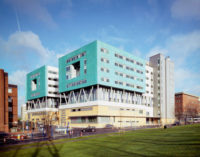Pendleton, Oregon
When St. Anthony Hospital’s new campus opened in rural Pendleton, Oregon, last winter, a local brewer made a special beer for the occasion—the “Hail Mary”—and roughly 3,000 people (in a town of under 17,000 residents) stopped by to check out the new digs. “There was just a sea of people wanting to see it,” says Kari Thorsen, an interior designer at the Seattle office of ZGF, the firm that designed the project. “It’s an amazing community with such a rich history. There’s such pride in the hospital.”
In the works for over a decade, the $74 million complex is a major upgrade from St. Anthony’s former quarters four miles to the northeast, where the hospital operated for over a century on an increasingly cramped nine-acre parcel across the street from the famous Pendleton Woolen Mills. Founded by the Sisters of St. Francis in 1902—the nuns are said to have supplemented the construction funds by leaving collection jars in the various brothels and saloons in town—St. Anthony underwent numerous expansions and renovations over the years. By the early 2000s, it was clear that building a new hospital would be more economical than continuing to sink money into maintenance. The old campus will be razed this summer.
With 25 inpatient beds in addition to outpatient and emergency services, St. Anthony is a Critical Access facility—the only hospital in a 28-mile radius—and is owned by Catholic Health Initiatives, a nonprofit conglomerate that runs 78 hospitals around the country and has worked with ZGF on numerous projects in the Pacific Northwest. For this project, the client had an unusual request: to keep costs down, the new 105,200-square-foot hospital needed to serve the same number of patients and have the same facilities in half the square footage of the old space.
With a compact footprint, the new hospital is designed to maximize daylight and access to the outdoors while keeping patient travel to a minimum. (In the old labyrinthine hospital, patients were routinely wheeled down several hallways and escorted up and down elevators, just to get from their rooms to the lab and imaging areas. To prevent that, hospital staff asked the architects to confine treatment areas to one level in the new facility.)
Most patients arrive through the main entrance, entering a light-filled double-height atrium and checking in at a leather and Douglas fir–lined reception desk, before taking a seat along the long public corridor, where patients and families can look out into the healing garden while they wait to be called. A private corridor for staff, emergencies, and patients requiring privacy runs parallel, along the opposite, eastern perimeter of the building. Patient-care services are sandwiched between the two hallways.
The more public double-height hallway gradually slopes downward, ending at the entrance to a chapel, which serves as a transition point where the quieter inpatient wing begins, in the northern volume. The chapel, a small square room with textured plaster walls and reclaimed-wood floors, has a band of wraparound 2-foot-tall glazing at floor level, just high enough to give visitors a glimpse of the healing garden while protecting their privacy. “We wanted folks to have a moment to themselves,” says ZGF project manager John Mess. “We were trying to bring in that natural, Western feel with simple materials.”
With a honky-tonk downtown on the National Register of Historic Places, an uninformed visitor walking along Main Street in Pendleton might mistake the architectural vernacular for, say, Texas. The town lives and breathes its pioneering past and has managed to turn it into a successful business: the Pendleton Round-Up, one of the largest rodeos in the U.S., is entering its 104th year. There is also a popular walking tour of Pendleton’s former red-light district, including access to underground tunnels built by Chinese migrant railroad workers in the late 1800s. “We tried to pick up on some of that history, but we didn’t necessarily give the hospital a plate ceiling, wagon wheels, and all that,” says Mess. “You’re getting some of that in the rustic wood, the fabric colors, and in the artwork from the Pacific Northwest, but we tried to incorporate it in a contemporary way.”
People
Owner:
Architect:
Personnel in architect's firm who should receive special credit:
Architect of record:
Interior designer:
Engineers:
Mechanical | Electrical:
Civil:
Consultant(s):
Landscape:
Lighting:
Acoustical:
Other:
Furniture:
Equipment:
Lean Design:
General contractor:
Photographer(s): Size: 105,200 square feet Construction Cost: $45 million Project Cost: $74 million Completion Date: September 2013 |
Products
Structural system
Manufacturer of any structural components unique to this project:
Exterior cladding
Metal Panels:
Metal/glass curtain wall:
Rainscreen:
Wood:
Moisture barrier:
Curtain wall:
Roofing
Windows
Glazing
Doors
Metal doors:
Wood doors:
Sliding doors:
Fire-control doors, security grilles:
Hardware
Acoustical Plaster:
Suspension grid:
Cabinetwork and custom woodwork:
Paints and stains:
Wall coverings:
Paneling:
Plastic laminate:
Solid surfacing:
Special surfacing:
Floor and wall tile:
Resilient flooring:
Vinyl, Composition:
Carpet:
Porcelain Tile:
Furnishings
Reception furniture:
Tables:
Upholstery:
Cafeteria:
Outdoor furniture:
Other furniture:
Lighting
Downlights:
Task lighting:
Exterior:
Dimming System or other lighting controls:
Conveyance
Plumbing
Add any additional building components or special equipment that made a significant contribution to this project: |








Post a comment to this article
Report Abusive Comment